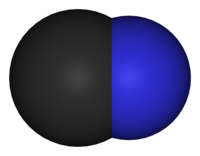Cyanides
 |
|
| Names | |
|---|---|
|
Systematic IUPAC name
Cyanide
|
|
| Identifiers | |
|
3D model (JSmol)
|
|
| ChEBI | |
| ChemSpider | |
|
PubChem CID
|
|
| UNII | |
|
|
|
|
| Properties | |
| CN− |
|
| Molar mass | 26.02 g·mol−1 |
|
Except where otherwise noted, data are given for materials in their standard state (at 25 °C [77 °F], 100 kPa).
|
|
| Infobox references | |
A cyanide is any chemical compound that contains monovalent combining group CN. This group, known as the cyano group, consists of a carbon atom triple-bonded to a nitrogen atom.
In inorganic cyanides, such as sodium cyanide and potassium cyanide, this group is present as the negatively charged polyatomic cyanide ion (CN−); these compounds, which are regarded as salts of hydrocyanic acid, are highly toxic. The cyanide ion is isoelectronic with carbon monoxide and with molecular nitrogen.
Organic cyanides are usually called nitriles; in these, the CN group is linked by a covalent bond to a carbon-containing group, such as methyl (CH3) in methyl cyanide (acetonitrile). Because they do not release cyanide ions, nitriles are generally less toxic, or in the case of insoluble polymers such as acrylic fiber, essentially nontoxic unless burned.
Hydrocyanic acid, also known as hydrogen cyanide, or HCN, is a highly volatile liquid used to prepare acrylonitrile, which is used in the production of acrylic fibers, synthetic rubber, and plastics. Cyanides are employed in a number of chemical processes, including fumigation, case hardening of iron and steel, electroplating, and the concentration of ores. In nature, substances yielding cyanide are present in certain seeds, such as the pit of the cherry and the seeds of apples.
...
Wikipedia
